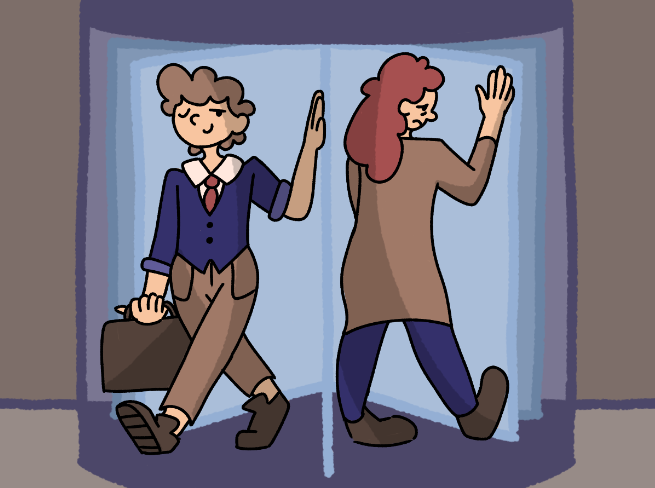
I was a little shocked. I accepted the video only because of my familiarity with Invisible Children. Global Issues paired with Invisible Children last year to help fund Calistus’ trip as part of a teacher exchange.
The exchange was a success. I thought both RBHS and Calistus’ school in Uganda benefited, but I was under the impression few people knew anything about Invisible Children, having only experienced moderate success with our fundraising attempts last year. I could be wrong, but it appeared a limited scope of people even knew about the fundraising before Calistus arrived, let alone that Invisible Children hosted it.
And that people became ardent Invisible Children enthusiasts overnight was disturbing.
But the turnaround was just as unbearable. When I logged onto Facebook earlier today, I saw one of my friends had posted a link questioning the Kony 2012 campaign and Invisible Children. While this in itself is not bad, repeated accusations and angry remarks toward Invisible Children are.
Though the Kony campaign is questionable and imperfect, this is the case with most not-for-profits, especially when meddling with controversies like the one in Uganda. Every organization requires enormous sums of money to fund travel and to pay workers. Transporting large numbers of people to and from Africa runs in the thousands per person (totaling $1.07 million in 2010, according to the organization’s IRS Form 990, found here*), and good publicity costs a fortune ($851,552 in 2010 for all production costs and $357,610 for film costs in 2010 relatively low for such high-impact films as the organization has pulled off).
The blog and many others that popped in my newsfeed questioned the exorbitant amounts the organization spends on making videos. But few documentaries capture an audience as Invisible Children’s documentaries have. Most organizations go completely unnoticed. This kind of advertising is essential for anyone to hear about their cause.
Think about this: few people heard about Kony’s deplorable acts last year when Global Issues, a school club, tried to raise the same issue. No one would have heard of Invisible Children had it not created the video.
Also, critics have blown the expenses out of proportion. Invisible Children’s revenue in 2010 was $13.77 million and its expenses amounted to $8.89 million, with $4.87 million going into savings. Around 65 percent of revenue covered expenses of running the organization, not an unreasonable amount especially considering the publicity the organization does.
The purported spendthrifts running the organization don’t make millions. The most any makes is $89,669 a year, according to Form 990, and this money goes to one of the founders of the organization.
The primary difference between Global Issues’ and Invisible Children’s focuses remained in education. Calistus came over to understand how American schools run and to take the teachings back and apply them to his school in Uganda. The Kony 2012 video’s focus was on mobilizing support for the troops that are already in Uganda, to spread knowledge.
If people don’t know or care about Kony, politicians could withdraw troops from the area. It is a great idea, but capturing Kony using troops is more questionable.
Funding the Ugandan military to capture Kony might not — and also might — be the best idea. To call Invisible Children a scam, however, is a hasty conclusion. To question its solution to the problem is reasonable. While I don’t know the best solution, and I think it’s impossible to know what the right thing to do is, I think the solution is something peacekeeping forces like the United Nations need to sort out, not one nation or one organization.
Though that’s just one high school student’s thoughts, I do think it’s important to question. Before jumping on either bandwagon, extreme loathing or love for the campaign, it’s important to question.
By Avantika Khatri
*As a side note, before jumping to conclusions about Invisible Children’s low rating on the site, check the dates on the comments
















































































Anna • Mar 15, 2012 at 10:50 am
I think that it’s frustrating when people are so quick to criticize the positive action of others. Sure, maybe those who had an immediate urge to involve themselves in the campaign were not fully educated on the issue, but at least they took action with good intentions. Those who were fully aware of invisible children before the Kony 2012 video are likely no more philanthropic than those striving to involve and educate themselves now. Having a “Holier than thou” attitute isn’t going to make a difference, but coming together and curbing the useless criticism of other’s action is a start.
Dan Scott • Mar 10, 2012 at 3:44 pm
[youtube http://www.youtube.com/watch?v=OrSkQzbOnR0&w=560&h=315%5D
Very healthy perspective highlighting a positive effect from social media trending on March 6, 2012.
Dan Scott • Mar 10, 2012 at 3:44 pm
Very Healthy Perspective, exlaining the potential of new social media trending on March 6, 2012.
[youtube http://www.youtube.com/watch?v=OrSkQzbOnR0&w=560&h=315%5D
Avantika Khatri • Mar 9, 2012 at 5:26 pm
For the record, the stats in here are only from what IC submitted to the IRS. Any under the table dealings (private donations perhaps?) would not be on here, and this data is 2 years old.
I still don’t know enough about the situation in Uganda to comment on that extensively. Maybe Kony is not in Uganda anymore, but abuses are still going on (maybe in DRC or elsewhere), and maybe Kony is dead. But someone is accountable.
http://www.nytimes.com/2012/03/09/world/africa/online-joseph-kony-and-a-ugandan-conflict-soar-to-topic-no-1.html – had a comment from the video creator. ““We view ourself as the Pixar of human rights stories.”
I don’t see a lot wrong with that. They sparked interest. Mission accomplished.
But the girl in the video made an interesting point that there’s not much left in Uganda, and there are things people should care about more, she mentioned Syria and Darfur.
I wouldn’t be surprised if IC is more selfish than I’ve mentioned. In the “Invisible Children” documentary, the IC people went to Sudan looking to catch war footage to make a documentary. They failed, so they went to Uganda instead. In was a moneymaking venture, and they made their documentary a hit by associating it with philanthropy. These are just my thoughts. Obviously no one actually said that. But they really don’t make that much money. Filmmakers make more money than they do. $80,000 is more than many Americans make, but it’s really very little for the founder of such a large organization.
IC does have a low % of the money going to causes, but awareness is a big thing that costs a lot of money as well. You can’t get money if people don’t know about it. Like I mentioned in my story. Spending money on awareness I think can be more effective than spending money directly on a cause.
My beef with people’s extreme loathing was that they called it a scam, and they all did it without much research (it seemed). They read one blog post and jumped to conclusions. Others watched the video and fanatically made posters the next day. Few people bothered understanding anything.
I’d like to think I’ve done at least a little more thinking than some of them have, and I still am not entirely sure how I feel for or against IC.
To dismiss something so quickly as a scam is reckless.
Rena • Mar 8, 2012 at 11:55 pm
I’ve only seen the perspective of Invisible Children supporters around school, so here’s Rosebell Kagumire’s (a Ugandan journalist and blogger’s who has covered the war) reaction to the Kony 2012 Campaign: http://www.youtube.com/watch?v=KLVY5jBnD-E#!
Apparently a lot of Ugandan bloggers and activists are worried about the repercussions from the Kony video, and from what I’ve seen online and at school, the “extreme loathing” is not just some urge to break from the norm in response to the suddenly popular movement. Rather, it seems to stem from the frustration of a sudden overnight onslaught of social justice warriors who are supporting a cause that calls for military intervention into a country whose history and peoples they don’t have the best understanding of, and then shaming those who say, “wait a minute, how effective is this really going to be?” It’s understandable that pointing out problems with this campaign can come off as “angry,” especially since it would be criticizing an organization people are passionate about like Invisible Children and their feel-good campaign, Kony 2012. It’s fine if someone has looked at the facts and says, “I think this is the best solution,” I just hope people aren’t confusing objective looks at the situation with defending Kony or something irrational like that. I myself was very moved by the video, so it’s not like I doubt that people’s intentions are in the right place. The video is very well done and should be commended for its prowess in rallying people for a cause but ultimately, it’s misleading. Plus, it does reinforce the White Man’s Burden narrative, which is echoed by Kagumire in her video. And just in case this post is making somebody’s blood boil, it is really not a personal attack on Kony 2012 supporters, nor am I just ranting “Invisible Children is bad rah rah because this or that and poo poo.” IC has done a lot of great things, and because I’m skeptical of the Kony 2012 campaign itself (which has thus far made me uneasy) does not mean that I completely object to the merits it does have. I’m not going to act like I have the most comprehensive knowledge of the intricacies of this conflict, but like Publius hinted, it’s really bigger than Kony. Yes, Kony is a figurehead but the armed intervention the Kony 2012 movement is asking for would most likely exacerbate the issue and escalate violence.
@Avantika, look into JP Morgan’s investments into Uganda. I don’t think IC is like some evil shady company but it’s hard to ignore the fact that they’re backed by an incredibly powerful company and their financial interests just happen to align. Invisible Children has gotten a lot of heat but they also have a spot on their website where they have responded to many of the common criticisms, and I thought it was interesting. There’s so much on both sides.
@Gregory, I feel like it’s “a discussion” not because it’s not a huge problem but because of the way this change is being sought. People totally agree that the scope of Kony’s actions are abhorrent and that he needs to be brought to court, it’s how best to go about it that’s the issue. It’s refreshing to see that the LRA is getting awareness, but most of the information in the video would have been more relevant say, five or six years ago, among a lot of other things. Also, could you argue that when “the nations of the top billion” commit crimes, they can get away with justifying their atrocities a whole lot more?
guest • Mar 8, 2012 at 11:27 pm
another perspective:
http://www.youtube.com/watch?feature=player_embedded&v=7DO73Ese25Y
gregory • Mar 8, 2012 at 7:19 pm
Kony has been indited by the International Criminal Court for war crimes and crimes against humanity. He is in fact wanted person #1. As a world community we have the obligation to affect his arrest and due process. We are 7 billion people with a very unequal distribution of wealth and resources. I can’t help but think that if the 30,000 children, that Joseph Kony bares the burden the responsibility for abducting and committing unimaginable atrocities, were from the nations of the top billion and not the bottom billion this would not even be a discussion. Let along if their skin were not so dark…
Publius • Mar 8, 2012 at 5:55 pm
Everything you said contradicts the last part of your post: “but it’s a step in the right direction.”
Asdf • Mar 8, 2012 at 5:41 pm
but couldn’t killing of kony help? i mean, it sounds kind of like 9/11. it’s not like al qaeda did much other than destroy morale and terrorize people. killing BL might have had an unforeseen impact. and doing away with kony might do the same. obviously he’s not the only perosn, but he’s a figurehead.
that’s probably sitll not the best way to deal with it, but it’s a step in the right direction.
Publius • Mar 8, 2012 at 3:58 pm
What happens after capturing/killing Kony? It’s like when we captured Osama Bin Laden everyone seems to have forgotten about Al Qaeda but, just like the drug cartels, another leader simply took his place. The idea of using Kony 2012 as a way to advertise for Invisible Children is brilliant, but an idealist like me is disappointed by the narrowness of mind it encourages- that once Kony is gone so is the problem.